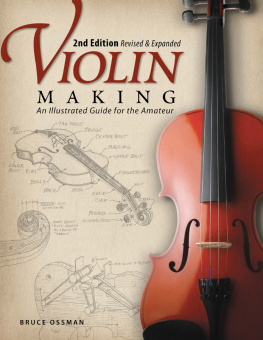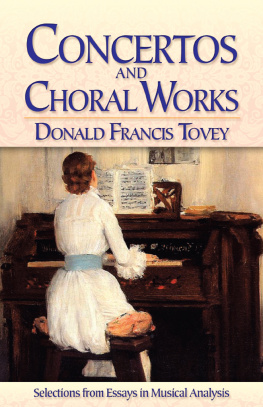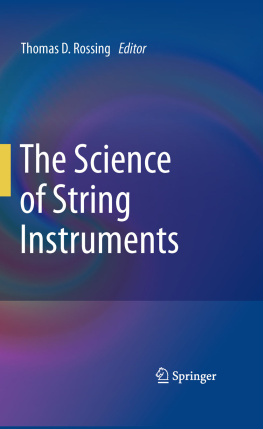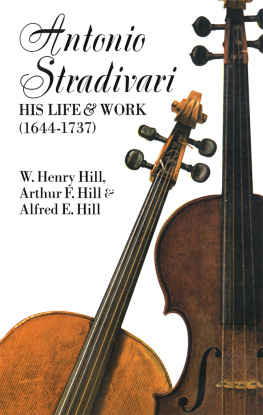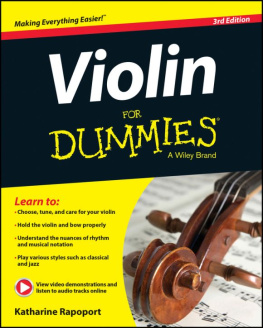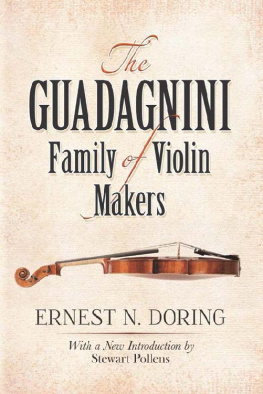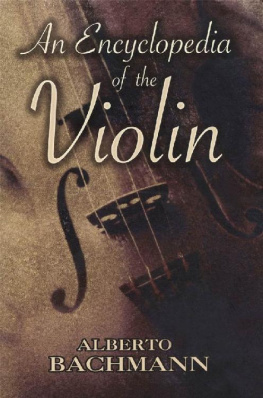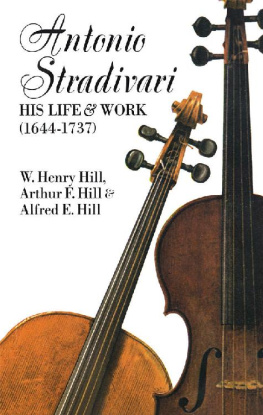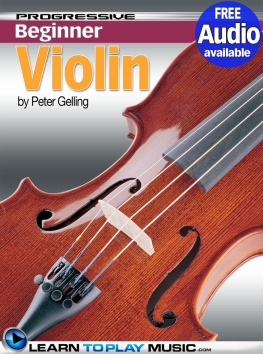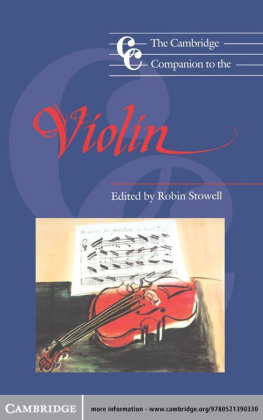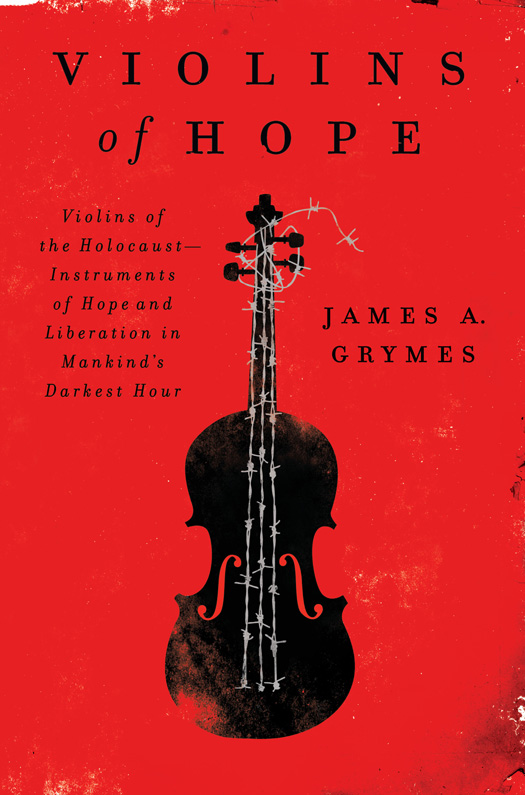We played music for sheer survival.
We made music in hell.
HEINZ COCO SCHUMANN
CONTENTS

Amnon and Moshe Weinstein repairing a double bass in their workshop, ca. 1965. Amnon continues to make and repair string instruments in this same workshop in Tel Aviv. (Courtesy of Amnon Weinstein.)
A mnon Weinsteins earliest memories are of his immediate family sitting around the table at major Jewish holidays like Rosh Hashanah and Passover in the late 1940s. There were four of them. Amnon, his little sister Esther, and their parents Moshe and Golda. And four hundred ghosts. These were the ghosts of the relatives who had been left behind when Moshe and Golda had immigrated to Palestine in 1938.
Moshe was a violinist, a violin teacher, and a violin repairman. He had been fascinated by the violin ever since he was seven years old, when he had heard a traveling Klezmer ensemble playing at a wedding in his hometown of Brest-Litovsk. Since there were no suitable violin teachers in Brest-Litovsk, Moshe traveled to Vilna, a Lithuanian city that was a capital of Jewish culture. There Moshe attended the same conservatory that Vilna native and violin virtuoso Jascha Heifetz had attended just a few years earlier. Moshe even won an award for performing Mendelssohns difficult violin concertothe same work with which Heifetz had made his debut. It was in Vilna that Moshe met his future wife Golda, who accompanied him on the piano.
After finishing their studies at the Vilna conservatory, Moshe and Golda decided to move to Palestine. They were Zionists, followers of a Jewish movement that called for a home and a national identity for Jews in the Land of Israel. Their four hundred relatives remained behind in Europe. Some, like Moshes father Yaakova rabbiconsidered the secular Zionist movement to be sacrilegious. They believed that returning to Israel prior to the arrival of the Messiah was contrary to Gods will. Others simply waited too long to secure the finances and paperwork necessary to travel to the Holy Land. When Germany invaded the Soviet Union on June 22, 1941, they became trapped in Nazi-occupied Eastern Europe.
Knowing that he would not be able to make a living as a violinist in Palestine, Moshe decided to become a violin repairman. The violin is a very popular instrument in Jewish culture, and Moshe wisely predicted that the tens of thousands of Jews who were immigrating to Palestine would create a market for an outstanding craftsman who could fix their instruments. In order to develop his skills, Moshe traveled to Warsaw to apprentice with Yaakov Zimmerman, a respected Jewish violinmaker.
Zimmerman is remembered as an outstanding artisan who was also very kind, especially toward young Jewish musicians. Famous violinist Ida Haendel, who was seven years old when her father brought her to Warsaw to study at the Chopin Conservatory, describes Zimmerman as a selfless person who would often repair instruments for free. Former concertmaster of the Berlin Philharmonic Michel Schwalb, who also trained in Warsaw, recalled how Zimmerman gave him everything he needed to play the violin, including instruments, strings, and bow hairs. Zimmerman even found a room in the apartment of Warsaw industrialist Shimon Krongold in which Schwalb could practice. For Jewish children like Haendel and Schwalb, this level of support was life-changing. Zimmerman disappeared during the Holocaust. It is assumed that he died in the Warsaw Ghetto.
Upon moving to Palestine, Moshe found a job picking oranges alongside numerous other immigrants in the agricultural community of Petah Tikvah. By 1939, he and Goldawho was also known as Zahava, the Hebrew form of her namehad earned enough money to move six and a half miles west to Tel Aviv. Moshe opened his violin shop and quickly established himself as a prominent figure in Tel Avivs burgeoning music scene. He was a peaceful man who thought that all children should learn to play the violin. People who played music, he believed, could be neither evil nor violent. While the exploitation of music during the Holocaust would prove him wrong, Moshe himself exemplified the noble principles behind his convictions by arranging scholarships that helped promising young talents like Pinchas Zukerman and Shlomo Mintz travel to the United States to receive the best training in the world at the Juilliard School.
Moshe and Golda also started a family. Their son Amnon was born in 1939. Their daughter Esther came along five years later.
By the end of the Holocaust, Moshe and Golda had heard very little from the relatives they had left behind. At first they had received a few letters asking for help with securing visas from family members who had hoped to join them in Palestine. But all communication had stopped once Germany had invaded the Soviet Union in June 1941.
Then a Holocaust survivor visited Moshe in Tel Aviv and told him how his entire family had been killed.
Before the war, Moshes family had moved to Volkovysk, which was occupied by the Nazis shortly after the German invasion. The Germans had started massacring Jews immediately. On November 2, 1942, all of the remaining Jews from Volkovysk and the surrounding areas were marched to a former prisoner-of-war camp. A number of Jews who tried to escape were caught and executed. One of them was Moshes brother, who was shot on the spot. By the end of the year, all but two thousand of the twenty thousand Jews in the camp would be sent to the Treblinka death camp. Everyone else was sent to Auschwitz on January 12, 1943.
The horrific stories were too much for Moshe to handle. That night, he suffered the first of many heart attacks that would ultimately cause his death. Moshe never spoke of his family again.
It was just as hard for Golda to talk about her family. They had remained behind in Vilna, which was occupied by the German army on June 24, 1941. The troops were quickly followed by death squads that began rounding up Jews and taking them to the nearby Ponary forest. Ponary had once been a popular weekend getaway for Vilnas Jews and gentiles alike. Now it would become the site of one of the most brutal massacres in the Holocaust. There were fifty-seven thousand Jews living in Vilna during the German invasion. By the time the Red Army liberated the city on July 13, 1944, only a few thousand remained. Like Moshe, none of Goldas relatives survived.
Racked with survivors guilt, Golda threw away the letters she had received from her family. The memories were like voices she could no longer bear to hear. When young Amnon asked about his grandparents, aunts, and uncles, she would struggle to find words that could explain why he would never be able to meet them. The best she could do was to bring out a book she had found about the Vilna ghetto and the Ponary massacre. This is where your grandparents are, she would tell him, pointing to the ghastly photos of the dead. This is my family. She would break down in tears, unable to explain further.
Although they could never bring themselves to discuss their dead relatives, the guilt and sorrow Moshe and Golda felt over their devastating losses permeated the Weinstein household, and with it Amnons childhood.
There were tangible reminders, as well.
Since Moshe was the president of the Association of Vilna Immigrants, the Weinstein apartment was the first stop in Palestine for survivors from Vilna who were hoping to start a new life in the land of their biblical ancestors. Moshe welcomed them all into his apartment for homemade meals and warm beds until they could find homes of their own. Young Amnon was frightened by the emaciated guests who were startled by every noise. He could not understand why they hid leftover bread under their pillows and blankets. Years passed until the sounds of the visitors crying themselves to sleep stopped resonating in his own nightmares.



